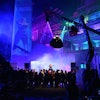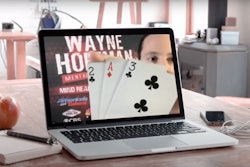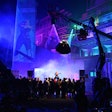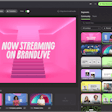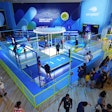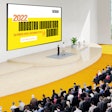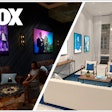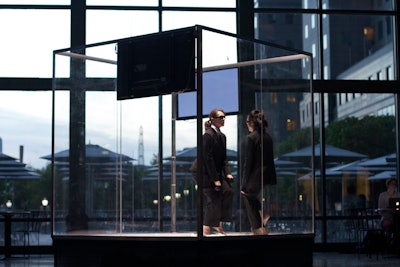
Over the last several years, like most live events, theatrical performances have become more immersive, participatory, and interactive, in part thanks to the popularity of shows like Sleep No More. But as with all IRL events, the COVID-19 pandemic has forced the curtain to close on these intimate in-person experiences, forcing them to work on a socially distanced stage.
Thankfully, the arts community knows how to improvise.
“I've been saying since day one of this pandemic, the artists are well equipped for this. We are accustomed to rolling with punches, figuring things out on the fly, doing a lot with a little, and communicating,” said Melanie Armer, co-founder of The Nerve Tank, a New York-based theater company that recently reimagined its 2011 performance of The Attendants for this new reality.
Originally staged at Brookfield Place in downtown Manhattan, The Attendants featured two performers confined in a giant Plexiglass cube, and they could use only their bodies to communicate with each other and passersby. Audience members would text or tweet messages to the performers; these commands would be displayed on a screen that was visible to all. The performers would then respond to them through movement.
As part of its “Brookfield Place at Home” campaign, Arts Brookfield commissioned an updated virtual version of the performance called The Attendants 2020—but this time, the clear cube was swapped for our collective computer screens.  Audience members would text or tweet messages to the performers at Brookfield Place.Photo: Caryn Waechter
Audience members would text or tweet messages to the performers at Brookfield Place.Photo: Caryn Waechter
Both the 2011 and 2020 performances, which are inspired by Samuel Beckett’s play Waiting for Godot, were a mix of choreography and free-form movement set to a soundscape. This year’s shows took place every Wednesday in June over the course of six hours and featured 10 performers streaming live from around the U.S. and Canada.
“This is both the hardest and the easiest rehearsal process I've ever had at the same time, and the hardest and easiest tech week I've had at the same time,” Armer joked about the digital process, which included prep work and rehearsals on Zoom, with live performances streamed via StreamYard and viewed on Twitch.
Armer and her co-founder, Chance Muehleck, “met” with each performer beforehand to discuss scenic design within their individual homes. “We chose a specific place in their house according to the same ideas in Beckett's work, creating a space that felt both trapped and also barren,” Armer explained. “Part of what we were trying to do was duplicate the sort of confinement of the cube with the frame of the [streaming] platform that we were using,” Muehleck added, “because we wanted to keep the idea that you're a little bit trapped, that we’re all trapped at home.”
“We were not trying to hide the fact that [the performers] were in their home. We were not trying to create additional scenery for them,” Armer said. “This piece went from being a project that had an entire eight-foot Plexiglass cube built for it in a lobby, to being a more site-responsive piece inside the framework of the internet.”
The duo also mailed the performers their costumes: a suit and tie. The ensemble was fitting for the 2011 performance, which took place in New York’s Financial District, but did seem odd to some viewers in our new pants-optional Zoom world.
 Viewers could communicate with the performers via text and the performers, who were streaming from their homes, responded in real time with their bodies.Photo: Courtesy of The Nerve Tank
Viewers could communicate with the performers via text and the performers, who were streaming from their homes, responded in real time with their bodies.Photo: Courtesy of The Nerve Tank
But despite the switch to digital, the messaging of the piece remained the same. “It's been about connection and the difficulty of connection,” Muehleck said, adding that, with this version it’s also about the “idea that some connection is better than none. Even a sort of two-dimensional virtual experience of sharing time with other people is probably better than nothing.”
As the audience explored this concept of connectivity, Armer and Muehleck also had to find a newfound connection with their performers.
“It's so interesting on the technical level and on the personal level because when you're in a rehearsal room with a group of people and you're leading that room as a director, part of your job is to understand what they're going through and feel what they're feeling and react in real time and help them and move obstacles out of their way so that they can do their work. That's a big part of directing,” Armer said. “And it was incredibly interesting to have to really learn new technologies and really use my words. ... You have to suddenly articulate each step of an emotional process.”
The Nerve Tank is currently working on translating its Glory Road production—which features a six-and-half-foot steel ball—into an online interactive experience, as well as figuring out how to bring The Attendants to a virtual corporate setting.
As the theater community wrestles with the merits of virtual versus in-person events, The Nerve Tank founders understand the opportunities and obstacles that this shift brings. “There are certainly things that you can accomplish online that you can't accomplish in person. This piece [of The Attendants] was broadcast in a way that could be seen worldwide. You didn't need to be in New York to see it. You can work with artists who are in other places, even other countries. The piece is not dependent on language, and so it translates that way pretty well. The costs go up in certain places, but overall the costs go down,” Armer said.
“So, on the one hand, it does open things up to a larger population, such as older people who don't go out to see live events. But it does take it away from people who don't have the technology to access it.”
